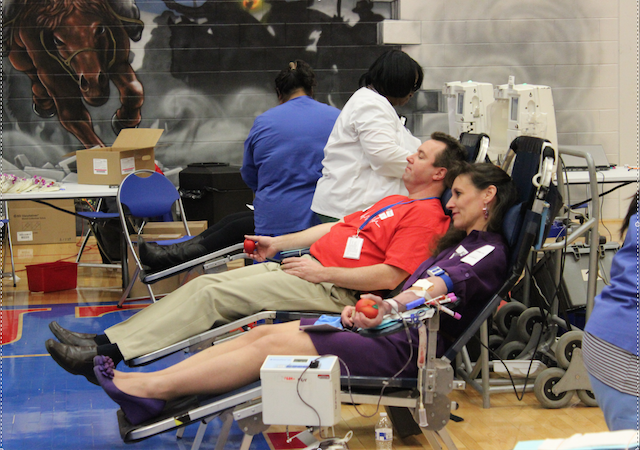Bad blood
April 29, 2015
On February 18th, Glenbard South welcomed LifeSource Blood Organization to hold a blood drive in the main gym. The drive was marketed as an opportunity to help save a life in the length of a gym period, and naturally many students were eager to help. The organization made it clear that students younger than 16, those who weighed less than 110 pounds, and those who did not have sufficient iron levels would not be allowed to donate blood. The organization did not disclose that homosexual men, according to the FDA, would be disqualified from donating blood and this is, unacceptable.
According to Life Source’s website, those who have engaged in “high-risk behavior” or had contact with someone at risk for HIV are disqualified from donating. This is the result of an FDA policy enacted in 1992 that aimed to prevent the intravenous transmission of HIV. At the time, the policy was a broad effort to minimize the risk of HIV blood and was logical because HIV transmission rates were at an all time high. However, the policy is outdated and poorly constructed; as it does not consider two important ideas.
First, the policy does not take into account the number of sexual partners a man has had or whether protection was used. It is without dispute that a gay man who had had sexual relations with numerous men, unprotected, in the last year would be considered to be more at risk for HIV than a heterosexual donor. However, what if a man has only had one sexual partner and used protection? The policy is homophobic. A straight person is not disqualified for holding multiple sexual partners or failing to use protection, but a gay man is even if he has held only one partner and used protection with that one partner. Because, according to the FDA policy, all gay men are “deferred” from donating blood and are to be registered as “deferrals” in that organization’s records so they cannot donate blood.
Second, the policy is backed by an overly broad concern.The FDA reports that all blood is tested for HIV; however, 1 in 2,000,000 tests will fail. What this means is that if a blood sample contained Human Immunodeficiency Virus, there is a 1 in 2,000,000 chance it would somehow enter the system. These are not likely odds. The amount of blood that would be gained if gay men were allowed to donate, assuming they have made safe sexual decisions (i.e. used protection and non promiscuous), is massive. To put it in numbers, there are 115,353,739 American men according to the 2010 US census. If roughly 3.8% of men are gay according to the Williams Institute of the University of California Los Angeles School of Law, then 4,383,442 men are gay. Considering the fact that every three seconds someone needs blood, if each of those men donated a pint of blood, around 13.9% of the need would be met. Donation age eligibility would obviously lessen this number as one must be 16 to donate with a parent’s signature; however, it would still be a sizable population. Sadly, according to the FDA not a single one of them can donate blood because they are gay. It is true, however, that with a recent update, those who have abstained from sex for at least a year are allowed to donate blood. The obvious issue with the update is that though that is a step in the right direction, adult men are sexual creatures and cannot be expected to abstain from being a human being for a year simply to donate a pint of blood.
Third, the policy is in place to prevent HIV infection, but it does not account for the fact that one does not have to be a homosexual man to contract HIV. The CDC reports, “In 2010, African American women accounted for 6,100 (29%) of the estimated new HIV infections among all adult and adolescent African Americans. This number represents a decrease of 21% since 2008. Most new HIV infections among African American women (87%; 5,300) are attributed to heterosexual contact,” (Centers). HIV does not just affect men; HIV does not just affect gay people. The policy claims to be there to account for even the slightest risk, ignoring the fact that gay men are not exclusively the carriers of HIV.
The policy also does not account for lying. To any question asked, the donor could lie. A gay man does not have to admit he is gay. However, many choose to be honest and are unfairly denied. The FDA should recognize that if the man is willing to admit he is a sexually active homosexual, he is likely willing to speak truthfully about his sex life. The survey should ask, “Have you had sexual contact with another male?” and if the answer is yes, there should be follow-up questions not automatic deferrals. Furthermore, the most important question should be, “Did you use protection/ have you had multiple sexual partners?” If the answer to the follow up question is deemed high-risk then the man should be deferred. He should not be deferred for simply being a sexually active gay man, that is not a disease, that is a sexual preference.
Overall, the ban on blood donation of gay men is intrinsically harmful. Criteria for eligibility should be based on sexual history, not preference. A heterosexual man who has had several unprotected sexual partners is more at risk than a gay man who has used protection with one partner.
The questionnaire should be based on the riskiness of decisions, not the gender of one’s “decision.”































